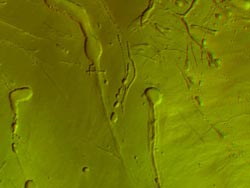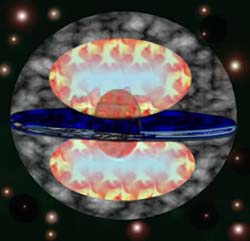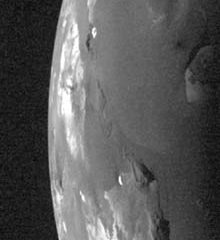Physics and Astronomy
This area deals with the fundamental laws and building blocks of nature and how they interact, the properties and the behavior of matter, and research into space and time and their structures.
innovations-report provides in-depth reports and articles on subjects such as astrophysics, laser technologies, nuclear, quantum, particle and solid-state physics, nanotechnologies, planetary research and findings (Mars, Venus) and developments related to the Hubble Telescope.

Physicists see golden needle in a micro-cosmic haystack
An international team of physicists examining an extremely rare form of subatomic particle decay — a veritable golden needle in a micro-cosmic haystack of 7.8 trillion candidates — has discovered evidence for the highly sought process, which could be an indication of new forces beyond those incorporated in the Standard Model of particle physics. That long-standing theory of all particle physics precisely predicts the rate of such decays to be half that observed by the experimenters although it is s

Ascraeus Mons in 3D
This 3D image shows a portion of the southern flank of Ascraeus Mons, the northernmost volcano of the Tharsis volcano group.
The peculiar depressions which can be observed here, and on several Martian volcanoes, are so-called ’lava tubes’. The anaglyph image has been calculated from the nadir and stereo channels and it was taken by the High Resolution Stereo Camera (HRSC) on Mars Express, from an altitude of 271 kilometres. North is at the right. The 3D image requires stereoscopic (red/gree

A White Dwarf Explodes Inside a Dense Circumstellar Disk
Peeking at a Puzzling Supernova with Spectropolarimetry
By measuring polarized light from an unusual exploding star, an international team of astrophysicists and astronomers has worked out the first detailed picture of a Type Ia supernova and the distinctive star system in which it exploded.
Using the European Southern Observatory’s Very Large Telescope in Chile, the researchers determined that supernova 2002ic exploded inside a flat, dense, clumpy disk of dust and gas

Sex and the City stars stay upright because h=Q.(12+3s/8) say scientists
As Sex and the City’s Carrie finally wanders off our television screens, physicists at the Institute of Physics have devised a formula that high-heel fans can use to work out just how high they can go. Based on your shoe size, the formula tells you the maximum height of heel you can wear without toppling over or suffering agonies.
h = Q.(12+3s /8)
h is the maximum height of the heel (in cm)
Q is a sociological factor and has a value between 0 and 1 (see below to work this

From Jupiter’s Moon, Io, come ideas about what Earth may have looked like as a newborn planet
Lava lakes could be Ionian versions of Earth’s mid-ocean ridges
Investigations into lava lakes on the surface of Io, the intensely volcanic moon that orbits Jupiter, may provide clues to what Earth looked like in its earliest phases, according to researchers at the University at Buffalo and NASA’s Jet Propulsion Laboratory.
“When I look at the data, it becomes startlingly suggestive to me that this may be a window onto the primitive history of Earth,” said Tracy K. P. G

Highway of WIMPs may solve cosmic mystery
Debris from gobbled-up galaxy could be ’smoking gun’ for dark matter
WIMPs speeding at 670,000 mph on a “highway” in space may be raining onto Earth – a phenomenon that might prove the existence of “dark matter” that makes up most our galaxy and one-fourth of the universe, says a study co-authored by a University of Utah physicist.
Many researchers have long suspected that dark matter may be made of WIMPS or Weakly Interacting Massive Particles, which are theorized subatomic